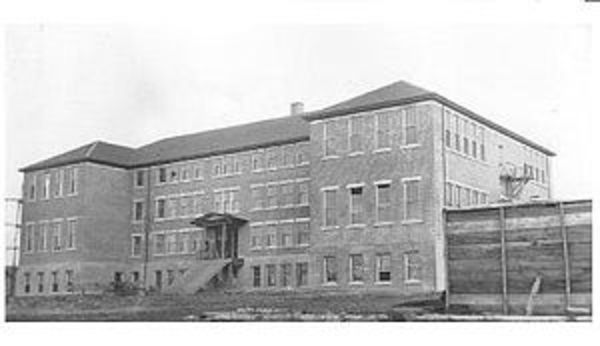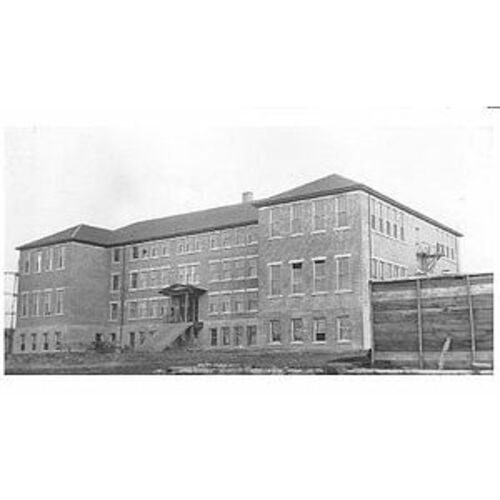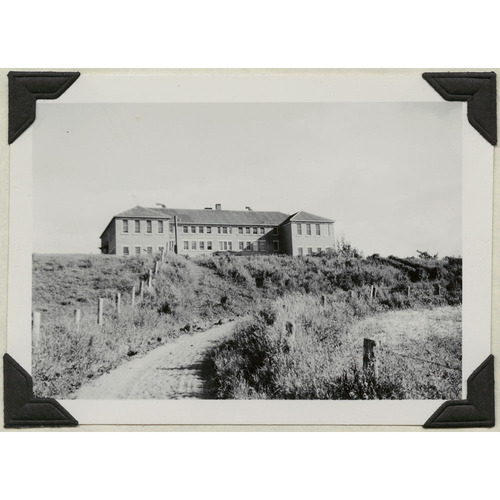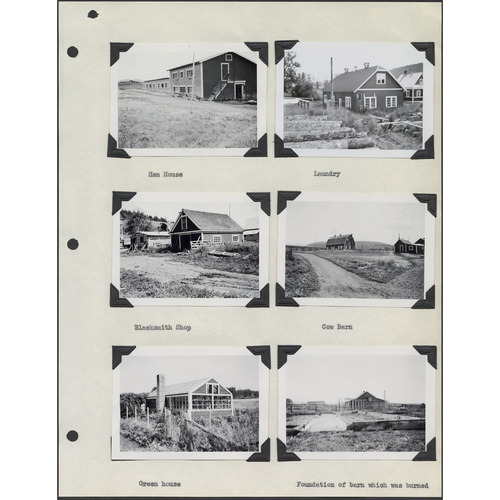
Source: Courtesy of Wikimedia Commons
WILLIE, ALLEN (Allan, Alan) PATRICK, schoolboy; b. 28 March 1928 on the Nautley (Fort Fraser) Indian Reserve No.1, B.C., son of Benoit Willie (d. 29 Sept. 1929) and Amelia François; d. 1 Jan. 1937 on Fraser Lake, B.C., and was buried in the cemetery on the reserve.
Allen Patrick Willie was born into a small Carrier (Dakelh) community on the Nautley reserve in British Columbia’s central interior. The reserve is located on the north side of the Nautley River (mistakenly labelled the Stellako River on maps published between 1930 and 1966), which connects Fraser Lake with the Nechako River, within the traditional territory of the Fraser Lake Indian Band. (The band became known as the Nadleh Whut’en First Nation and the Stellat’en First Nation in 1990.) During the late 19th and early 20th centuries residents of the region had experienced rapid social, economic, and cultural changes, which were catalyzed by the construction of the Grand Trunk Pacific Railway, completed in 1914. Subsequently, wage labour became increasingly available as Euro-American settlement and mining intensified. Subsistence and trade that had traditionally centred on hunting, fishing, and trapping persisted, but state-imposed regulations pushed the Carrier from communal usage of land towards family-based ownership, a process that was facilitated by pressure to register private traplines in the 1920s and 1930s.
Among these changes, the effort to assimilate Indigenous children into settler culture had far-reaching consequences for the Carrier community. Duncan Campbell Scott*, the deputy superintendent general of the Department of Indian Affairs (DIA), had arranged for a 1920 amendment to the Indian Act that made it mandatory for Indigenous children between the ages of 7 and 15 to attend a day, industrial, or boarding (residential) school as may be designated by the superintendent general. The amendment also made provision for parents or guardians to be fined and/or jailed for up to ten days if they did not comply with authorities three days after receiving notice. Many Carrier saw the advantages that official instruction might offer to their people by helping them adapt to a changing society, and they had called for the creation of local day schools that would incorporate their customs and culture into the curriculum. The Carrier had first asked the federal government to grant them access to public education in 1867, and they repeated the request into the 1920s, although very few Carrier children went to school before 1922. The residential schools – funded by the government in collaboration with the country’s major churches [see Émile Grouard; George Holmes*; Joseph Hugonard*] – were intended to assimilate children into Euro-Canadian society by removing them from the influence of their families, communities, and cultures. Within this context, and under the authority of the Oblates of Mary Immaculate, the Fraser Lake Indian Boarding School was opened on 17 Jan. 1922 near the middle of the south shore of the lake; it was renamed the Lejac Indian Residential School nine years later.
Allen, whose mother and stepfather, Sylvester Patrick, had attended a missionary-run day school, was one of more than 150,000 Indigenous children enrolled in Canada’s residential-school program between the late 1880s and 1996. He entered Lejac in 1935 at age seven. The account of elder Mary John of the nearby Stoney Creek Band (Saik’uz First Nation), who entered the same school in 1922, offers a glimpse of the traditional Carrier lifestyle in the early 20th century. Published in 1988, her story emphasizes the importance of the relationship between children and their families and of the use of the Carrier language. She recalls that the school enforced hard menial labour for children, and harsh corporal punishment was meted out to runaways. In 1927 her mother refused to return her to the school at the end of a visit to her family. During the DIA inquiry that followed Allen’s death, Father Patrick McGrath estimated that 90 per cent of parents opposed their children’s attendance at the institution. Although many Indigenous communities had advocated for access to education for their children, many individuals turned against the residential-school system because of the conditions to which students were subjected [see Frederick Ogilvie Loft]. Parents often hid their children from authorities; some openly defied Indian agents and police officers, and were jailed.
Conditions at Lejac were typical of those that usually prevailed at residential schools. In 1907 Peter Henderson Bryce, chief medical officer for the DIA, had described the conditions he witnessed in such schools as “criminal.” The work of scholars and the testimony of thousands of survivors to the Truth and Reconciliation Commission of Canada (TRCC), which conducted hearings between 2008 and 2015, describe untrained teachers, inadequate food, insufficient clothing, a lack of sanitation, overcrowding, and constant hard labour, as well as physical, sexual, and spiritual abuse. The results were often illness and death. In its report, released in June 2015, the TRCC states that it had identified 3,201 Indigenous students who died while at residential schools, although the report stresses that, since health records were regularly destroyed, the real number is probably much higher. Doctors, Indian agents, and First Nations peoples had frequently complained about conditions, and the DIA was aware of the schools’ failings. Loneliness, abuse, forced separation from family, and the loss of community were devastating. In addition, students were forbidden to speak their native languages and perform Indigenous cultural and spiritual rites.
Such factors contributed to Allen’s decision to run away in January 1937. It was his second attempt; the first time he was caught and subjected to corporal punishment. After Oblate bishop Jean-Louis-Antoine Coudert denied permission for Allen and fellow students Andrew Paul, John Michael (also known as Michel and Jack), Maurice Justin (also known as Justa Maurice), and Paul Alex to return to their community for a New Year’s gathering, they fled the school late in the afternoon of 1 January. Although Alex turned back, the four other boys, dressed in light clothing, followed the Grand Trunk Pacific Railway southeast before attempting to cross Fraser Lake. The temperature dropped from -4ºF to -22ºF, the ice was buried under five to six inches of snow, and they soon found themselves travelling in the dark.
Staff had noticed the boys’ absence during dinner on 1 January and reported it to school authorities, but it was not until 5:00 p.m. on 2 January that parents and community members on the Nautley reserve were told that the children were missing, after which a search party was deployed. Their frozen bodies were quickly found; they were lying a little more than half a mile from the community beside open water at the outflow of the Nautley River. The coroner’s inquest conducted on 3 January found that the boys had died of exhaustion and hypothermia just before midnight, and revealed confusion over who was in charge at the school that evening. Although the tragedy made national headlines, no individuals were held accountable. A DIA inquest followed in March, and concluded that if a search had been initiated when the boys’ absence was reported, they would almost certainly have been found alive.
Sadly, this episode at Lejac was not an isolated incident – almost exactly one year later, the school’s quarterly report describes “an epidemic of runaway boys.” Other examples of students trying to escape were not uncommon, within central British Columbia and elsewhere. A Shuswap boy had died while running away from the Oblate school at Williams Lake in the winter of 1902, and there was a case, in 1920, of eight Shuswap boys who made a suicide pact to eat a poisonous plant, which killed one of them.
With some exceptions [see William Morris Graham], residential schools have come to be seen as pedagogical failures that devastated Indigenous people across Canada. Although there remain few traces of the life of Allen Willie, the story of his untimely death is emblematic of the deplorable conditions endured by so many young Indigenous people – which they found so traumatizing that many risked their lives to try to escape them.
LAC, R216-247-1. Gazette (Montreal), 6 Jan. 1937. Globe, 5 Jan. 1937. Manitoba Free Press, 5 Jan. 1937. Vancouver Sun, 6 Jan. 1937. Can., Indian claims commission, Nadleh Whut’en First Nation: Lejac School inquiry (Ottawa, 2008); Truth and Reconciliation Commission of Can., Honoring the truth, reconciling the future … (Winnipeg, 2015). Jo-Anne Fiske, “Life at Lejac,” in Sa Ts’e: historical perspectives on northern British Columbia, ed. Thomas Thorner (Prince George, B.C., 1989), 235–72. Elizabeth Furniss, Victims of benevolence: the dark legacy of the Williams Lake Residential School (Vancouver, 2000). M.‑E. Kelm, Colonizing bodies: aboriginal health and healing in British Columbia, 1900–50 (Vancouver, 1998). J. S. Milloy, A national crime: the Canadian government and the residential school system, 1879–1986 (Winnipeg, 1999). Bridget Moran, Stoney Creek woman: the story of Mary John (Vancouver, 1988).
Bibliography for the revised version:
Can., Statutes, 1920, c.50.
Cite This Article
Brendan Plummer and James McKenzie, “WILLIE, ALLEN (Allan, Alan) PATRICK,” in Dictionary of Canadian Biography, vol. 16, University of Toronto/Université Laval, 2003–, accessed December 30, 2025, https://www.biographi.ca/en/bio/willie_allen_patrick_14E.html.
The citation above shows the format for footnotes and endnotes according to the Chicago manual of style (16th edition). Information to be used in other citation formats:
| Permalink: | https://www.biographi.ca/en/bio/willie_allen_patrick_14E.html |
| Author of Article: | Brendan Plummer and James McKenzie |
| Title of Article: | WILLIE, ALLEN (Allan, Alan) PATRICK |
| Publication Name: | Dictionary of Canadian Biography, vol. 16 |
| Publisher: | University of Toronto/Université Laval |
| Year of publication: | 2018 |
| Year of revision: | 2023 |
| Access Date: | December 30, 2025 |





